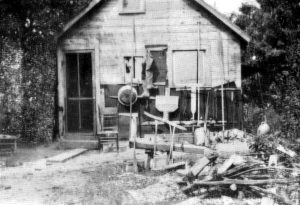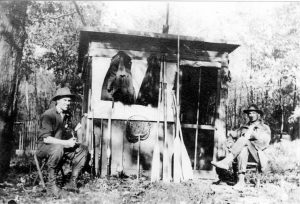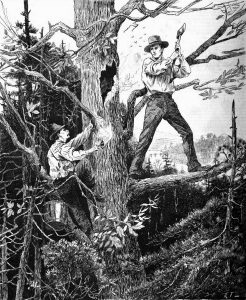CHAPTER VIII
TRAPPERS’ CLAIMS
TRAPPERS’ CLAIMS
AND HOW THEY WERE
OBTAINED. THE BEE-TREE
SWINDLE AND HOW
IT WAS WORKED
By: J. Lorenzo Werich
It was away back in I868. Think of it. Fifty years ago when I made my first appearance in the Kankakee Swamps. Since then I have hunted in swamps and on mountains, in the big forests and on the plains, but none clings to my memory quite so well as when my thoughts ramble to the days when I was trapping the furbearing animals in the Kankakee region. There are many very funny things happened in those old hunting days.
I told my early experiences in the first chapter of this book from the angle of a pioneer hunter of the west, although it did not all center in the Kankakee Swamps then as it has in later years, for many big hunts that won me fame was west of the Mississippi River, years ago. Whilst writing this story and talking with old friends I have been living over those old days, it has freshened memories of incidents that I have not thought of for years.
In the early 60’s, during the Civil War, the price of furs of all kinds went up. A mink hide would sell from four to nine dollars each. A good coon skin would bring four dollars and a half, just as it was nailed on the shanty door, and the fur buyer would pull the nails himself. All kinds of furs brought a good price and for this reason many hunters were brought to the Kankakee Swamps. Also, many trappers were brought here.
Up to this time the pioneer trappers had no established trapping grounds as there was a vast territory along the river covered with water the whole year round which furnished good trapping grounds anywhere. He saw that his rights were slipping from him and that he would soon be crowded out of a trapping ground. So some of the old pioneer trappers got together and established what is known as a trappers’ claim. Some held certain claims upon rights of permission, others from permission of the landowners, while still others had bought their grounds. These trapping grounds or claims, as they were sometimes called, were divided by a line running north and south as the river is supposed to flow from the northeast in a southwestern course. So the miles on the river were the base lines of the claims and extended on both sides of the river just as far as it was profitable and ran all the way from two to ten miles in width. Therefore, there were a good many trapping grounds lying between the Indiana State line and English Lake.
These, claims were bought and sold almost the same as real estate and they were about as strong in their stipulation as the Glayton-Bulwort treaty, They have brought many a trapper on the verge of war. Among the early trappers who came in the late fifties and early sixties were: Joshua E. Essex, better known among the old-time hunters as “Essex, the Beehunter” from the fact that he was one of the greatest wild bee hunters that ever hunted the Kankakee region. He began hunting and trapping in I859 in partnership with J. E. Gilson, of whom mention has been made. They built a log cabin on what is known as Butternut Ridge and near the Swift Cut Off. Here he trapped for three years then went into partnership with Charles Cassel and on Shanty Island built a shanty and trapped three years. In the summer of I862 he enlisted and was enrolled in Company I, 5th Regiment. Indiana Cavalry. He was Quartermaster Sergeant and served to the close of the war, being discharged on June I5. I865, when he returned and again went into the swamps and continued hunting and trapping until I880.
Most of his time in the swamps was spent in hunting bees. He became famous as a bee hunter. After retiring from the trapping business for many years he devoted his time to the bee culture, having in the meantime invented and patented a bee hive which he manufactured and sold. It was a great improvement over the old-fashioned bee hive.
In the winter of I867 Samuel Irvin began trapping and built a shanty on Little Beach Ridge, Eben Buck, an old pioneer river man, was his skinner and fur dresser. It is said that Buck could skin and dress more hides in an hour than any two trappers on the river. In stretching and dressing a rat hide he was an expert.
In the fall of ‘7I Irvin built a shanty on Quinn’s Island on the north side of the river and a little below the north bend. This shanty he used for two seasons then found that he had been encroaching upon the rights of another trapper. Then he sold his shanty to Bill Granger. Folsom moved it to Red Oak and placed it on the site of the one that was burned in ’73, In the same year Irvin bought another claim or rather two claims, the Indian Garden Claim and the Crooked Creek Claim, This purchase extended his trapping grounds up the river as far as Crooked Creek. He built a shanty on Indian Garden near the mouth of Sandy Hook. Late in the Fall of ’79, after the fall catch, he sold his claim including shanty, boats and traps to the Sherwood Brothers, Jerry and Holland, for one hundred and fifty dollars. He also realized one hundred and forty dollars from one month’s trapping, thus retiring from the business after spending twelve years of successful trapping on the Kankakee.
The latch string of Mr. Irvin’s shanty door always hung out to all hunters and fishermen from far and near and they were hospitably treated and entertained, The Sherwoods trapped the ground one or two seasons, then sold out and moved to Tennessee. Another very successful trapper in those days was H. G. Castle who began trapping with his cousin, Charles Castle. They trapped in the Shanty Island ground for several years and bought furs. He retired in ’82 and engaged in the mercantile business at Hebron Indiana.
By I882 nearly all the old-timers had left the swamps. Furs were getting cheap and hardly worth catching. But a few years later prices began to go up and then the younger generation took up the trapping business. Now as I have gone to the limit of this story or what I promised in the beginning, The Pioneer Hunters and Trappers, I will leave the latter-day hunters for the second edition.
The reader remembers I said that Essex was a great bee hunter and to my mind he was. But he had many close rivals in hunting for wild honey. Now I will tell you of one of the shrewdest bee hunters that ever operated in the Kankakee Swamps. He said that “there are tricks to all trades” and a stunt that he pulled off and got away with, or rather a “joke” as he called it surely proves the assertion of good or evil repute of past Sawyers or Sawyers yet to grow. Henry B. Sawyer was related to the Mr. Sawyer who many years ago ran the Eatons Ferry and of which I will speak later. This young hunter who originated in Kentucky but later at Big Log, Indiana, has friends who have determined that he is a natural born hunter (Kentucky produces a large crop of such). Sawyer was long armed and amiable. From many years, of practice in hunting and shooting wild fowls, deer and wild hogs and other game which inhabited the Kankakee region had a fairly correct notion of his own about hunting, Many of the sportsmen from the city would employ him and turn over their camp to him and at night he would teach them local geography of the Kankakee region. In a few years he became known to almost all the sportsmen in the nearby cities.
The business of a guide in those days was to push a boat through the swamps, bayous and sand marshes with one, and sometimes two, hunters in it. At times there was much hard work to perform, especially in the fall hunt when the water was low. In a year or two he grew tired of this business and his thoughts seemed to consist as far as might be to avoid work. And here he invented his practical ‘”joke,” Sawyer was struck on the idea of bee-hunting, As he was well known by all of the old bee hunters along the Kankakee he was welcomed as joyously at a bee hunters cabin as if he were a long missing brother. He was at once made to be at home in the bee hunters cabin on Long Ridge, whilst the old hunter entered with a friendly rivalry with the young hunter in the giving of advice and information. After visiting a number of the old-time bee hunters who resided among the sand ridges along the river, one of them was Honey Bee Sawyer. He thought he had the secret, so he began looking for wild bees that stored their honey in hollow trees which were called bee trees.
Honey sold at a good price in those days as there were not many hunters engaged in the business. When Sawyer began hunting the wild bees it was in the Autumn of “59”. At that time there were several good bee hunters in the swamp among whom I might mention the Steven brothers, Marion and Pilander, Harrison Dolson, Joe Cason, Had Folsom, Charles Cannon, and a score of others that were very successful bee hunters. They were all old timers who had followed the business for years. Sawyer was green at bee hunting as I said before, but he hit on a scheme that worked and laid the old bee hunters in the shade. Me was always a lucky hunter. Good luck seemed always at his hand, No matter what the game was he pursued, he always was sure to bag it, and so the same luck followed him in the bee hunting business.
He found two or three trees, cut them, and they proved good, getting from sixty to one-hundred and fifty pounds per tree. Being a good season for honey, as there were lots of wild flowers for the bees to work on, Sawyer conceived the idea to mark every tree that he found that had a hole in it, to mark them all bee trees, generally picking on trees that were easily climbed. He had a pair of climbers made something on the order that telegraph linemen use. He had everything in readiness and just as soon as the frost came and hilled the flowers so the bees would have to work on bait he was ready for them.
As I said nearly every tree with a hole in it had his name on it and it is very seldom that you hear of a marked bee tree being disturbed. Before close of the bee hunting season Sawyer went around to all the trees that he had his name on, climbed them, stuck some honey-comb inside of the tree and smeared honey all around the hole so that all the neighborhood bees would work on the honey, passing in and out of the hole in the hollow tree. This the bees will do late in the Fall when the flowers are gone. After baiting about sixty-five or seventy trees in this way, having three or four live trees, genuine bee trees, he announced his trees for sale and in a few days he had his victim coming.
Some settlers from the ridges, hearing of the result of some of Sawyer’s bee trees, concluded there was a chance for speculation, so some of them visited the young bee hunter who had a shanty on Buck’s Ridge, with a view of buying some of his trees. As good luck would have it, it was a warm, sunny day in the middle of October and the bees worked on bait nicely. Sawyer took them through the swamp, over ridges and showed them his stock of bee trees. The bees were working strong, going in and out of the trees, indicating a strong swarm. Sounding the trees with the pole of an axe gave them some idea as to the hollow that the tree might contain.
After examining the trees, the party returned to the cabin late in the afternoon tired, wet and hungry, The trapper who was shantying with him had a kettle of stewed duck, boiled potatoes, bread, butter and coffee, which made a fairly good supper, Sawyer asked them three dollars and fifty cents a tree and showed them the honey that he took out of a tree that he cut. He said he had sold six dollars worth of honey and if they doubted his statement they could ask Mr. Smith, the man who helped him cut the tree and take the honey out. The settlers hesitated for awhile, but finally said they would give him two dollars and fifty cents a tree for sixty-five trees.
There were three trees on the north side of the river they did not want. Sawyer did not want to miss a sale so he said that he would cut two trees near the cabin and if they did not get more than one hundred and fifty pounds from the two trees he would take the two fifty. And if there was more than that they were to give him the three fifty. To this they agreed. They went to cut the trees and from the first one they got a little over one hundred pounds of nice honey. The other tree was still better, They soon closed the deal. Sawyer was to help them cut the trees and the time was decided on the first freeze up when the ice would carry them safely, as that would be the best time to get around in the swamp and get the honey out.
The bargain was closed and Sawyer received his money, two hundred and twenty-seven dollars for five bee trees-, whilst the sixty trees contained nothing but the hollows. Not a bee in the whole sixty trees or for a long time afterwards. This was known as the “hollow tree sale.” Just before or about the time of the first freeze Sawyer left the ridge and a paper informing the settlers that all kinds of things happen in the Kankakee Swamps, he took the map of the Kankakee valley and departed.
A few days later the settlers came and had a bee tree cutting. They cut several trees and did not find any honey nor bees but found a piece of honey-comb on a string inside the tree. This led them to believe that they had been tricked. They went to their homes much wiser. but with no honey. What they said of their experience was never known.
A few days after this an old bee hunter asked one of them how much honey they got. He drew a long hunting knife and threatened the inquirer. The other settlers were questioned not at all. It was one of the shrewdest tricks ever pulled off in the history of the Kankakee Valley, His fame as a bee hunter went abroad all over Northern Indiana and he was thence after known as Honey Bee Sawyer, and this done on his achievement is not dimmed or forgotten. Pather was quite a successful bee hunter and in early days kept the home supplied with wild honey all the year round and from him I got my early training in bee hunting.
Although I never hunted for bees very much yet it is one of the sweetest hunts that a man can engage in. I never found very many bee trees and what I did find I found mostly when I was not looking for them. When a boy I used to go with Father when he went bee hunting In the fall of the year after the frost had killed the wild flowers the bees would work on bait and by putting some honey-comb, stuck on a stick, in some open place, then watch for the bees, and if there are any bees within a half mile they will come to the bait and after they have loaded themselves with honey they will rise, circle around once or twice then start straight for home. Then the hunter gets the line on the direction of the tree. Possibly many of you have heard, the old saying “Straight as a bee line.” Well, this is where that old saying originated. A bee never flies a crooked line to its home when loaded.





